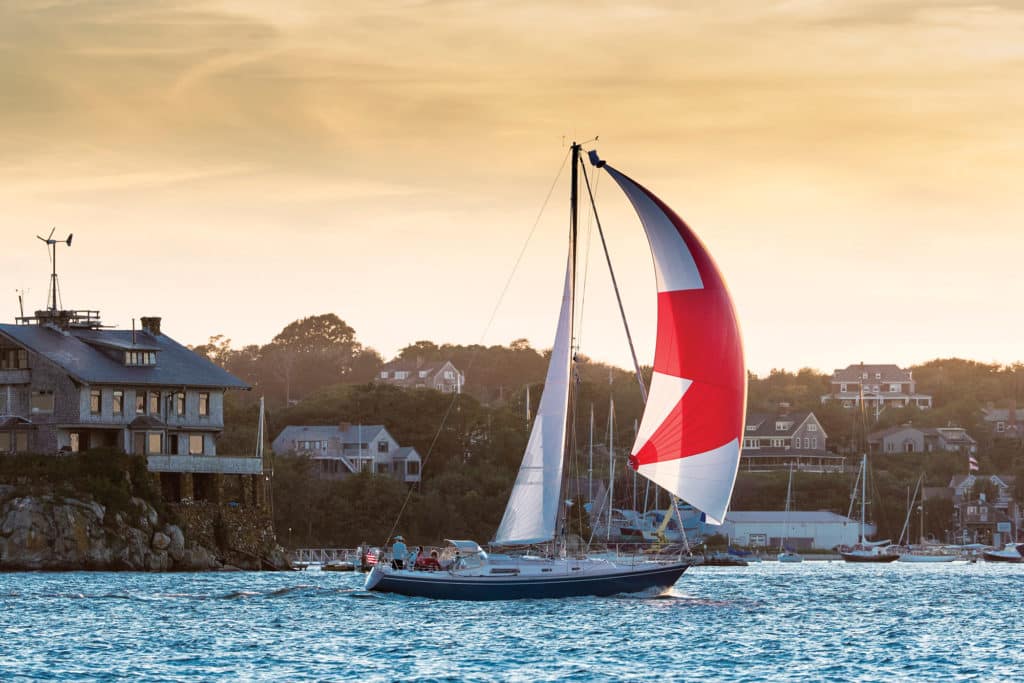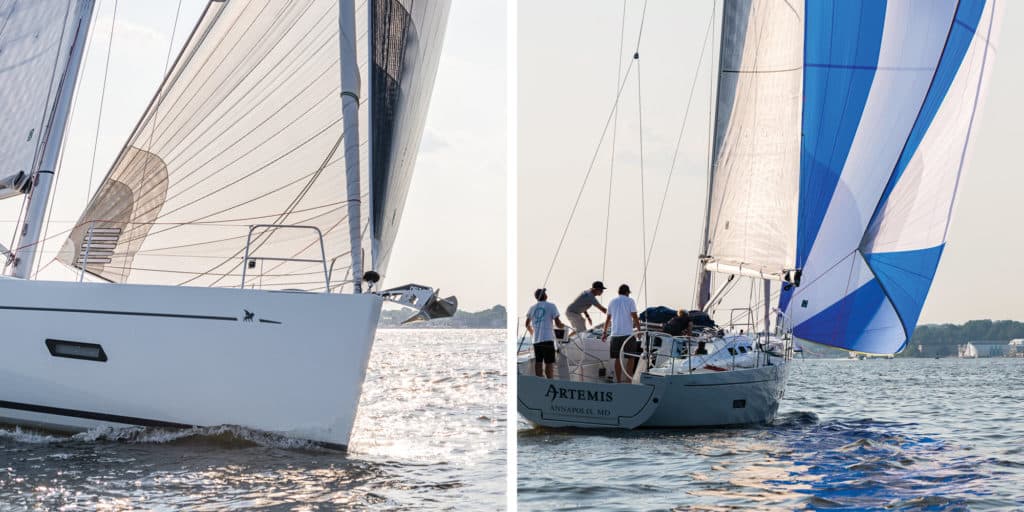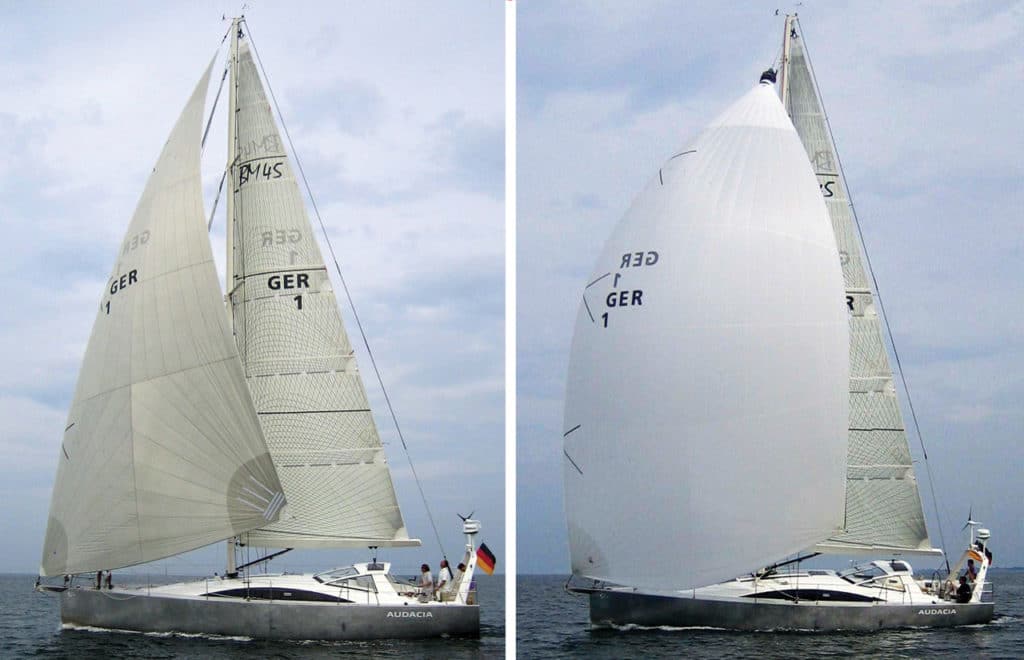
Not so long ago, most production sailboats featured sail plans that were a bit different from what one might encounter when looking at how boats are rigged today. For example, older sloops typically carry 130 to 150 percent genoas that, when sheeted hard on the wind, extend well aft of the shrouds. While these large headsails demand some grunting on the winches to haul in the sheets during tacks—and typically require roller reefing or downshifting to a smaller jib when the breeze freshens—they allow boats to sail deeper angles without hoisting dedicated off-the-wind sails for reaching and running downwind.
By contrast, the current trend in sail plans typically features a larger mainsail and non-overlapping or just slightly overlapping headsail, typically in the range of 107 percent. While this approach makes it relatively easy to trim the jib while tacking upwind, as soon as the boat cracks off and sheets are eased, boatspeed drops, especially in the lighter airs that are common to coastal waters during the summer months.
To address this loss of power, today’s sailmakers offer dedicated off-wind sails that liven up performance when sailing deeper angles. I reached out to three leading sailmakers—Dan Kaseler, who owns Quantum Sails’ Seattle loft; Adam Loory, who works as UK Sailmakers International’s general manager; and Bob Meagher, from North Sails’ Fort Lauderdale loft—to learn more about the best options for cruisers.
In all cases, the sails they recommend are custom-designed and built for the owners and the boats that will use them. Here’s what I learned, starting with the most weatherly sail and clocking back to those that are better-suited for deep-angle runs.
Code Zeros
These rockets came to fame aboard racing sailboats in the late 1990s and early 2000s, allowing racers to quickly fetch deeper angles than a racing headsail could efficiently carry. For race boats, code zeros are subject to specific rules that describe their midgirth measurement (namely, 75 percent of their foot length). Cruising code zeros aren’t subject to these same constraints, however. As a result, midgirth measurements that run 55 to 65 percent of the sail’s foot measurement are common, making them easier to sail and friendlier to furl.
A cruising code zero typically would be used when sailing on any point from a close reach to a shallower broad reach, with their sweet spot ranging from 75 to 125 degrees true wind angle, depending on their midgirth measurements; the larger the percentage, the deeper the sail can be carried. They can be made from a variety of materials to match a customer’s needs and budget. “Code zeros take the place of 150 percent genoas, and then some,” Quantum’s Kaseler says. “But they’re not good for deep angles. If you try to fly them dead downwind, they’ll fall out of the sky.”
While the DNA of today’s cruising code zeros is rooted in the racing world, UK’s Loory makes it clear that these sails are far different from what can be found aboard a modern TP52 racing sloop.
“Cruising code zeros are flat, reaching spinnakers on furlers,” Loory says. “If cruisers want to sail closer to the wind with their code zeros, they’ll need a stronger sail that’s made out of laminated fabrics. If they’re not concerned with sailing close to the wind, the sail can be made from a performance 1.5-ounce nylon.”
As Loory notes, code zeros typically reside on furlers, allowing them to be deployed quickly, and are tacked to a hard point that’s in front of the forestay. Unlike jibs and genoas, which use furlers with drums that contain the furling line when the sail is deployed, code zeros tend to employ continuous-line furlers (pull one direction and the sail unwinds; pull the other direction and it refurls) that furl the sail from its bottom up or from the top of its leech downward (the latter are known as top-down furlers). This arrangement, Kaseler says, requires that the sailmaker incorporate a torsion rope on the sail’s front edge. This torsion rope can be attached to the head of the sail or it can be integral to the sail. Either way, the torsion rope’s job is to provide a stiff, shroudlike member that translates effort from the furling line to a clean and tight top-down furl.
Also, unlike furlers used to roll up jibs and genoas, code-zero furling drums are usually dedicated to the sail, so when it’s time to lower the rolled-up sausage and store the sail, the furler goes into the sail bag with it.
Unlike other sailmakers, North Sails refers to its code-zero-style sails as G0s, with the “G” standing for “gennaker.”

One consideration when buying a G0, says North Sails’ Meagher, is whether the sail will live belowdecks and come up for occasional deployment, or whether it will remain furled-up and hoisted, ready to be unwound as the wind angle dictates. While the always-up option is easiest to use, it requires special consideration when the sail is being designed. “You’ll need a sun cover, which is a light, 6-ounce fabric,” Meagher says. “But there’s a practical limit to a sail that can carry a 6-ounce sun cover—your sailmaker will need to increase the sail’s weight and stretch resistance.” This, he notes, typically means that the sail will need to be built out of 2- or 3-ounce fabric. “You can use lighter sailcloth, but the sun cover will usually shrink and pucker the sail material.”
Also, Loory says, it’s important to remember that a sun cover that’s light enough to be flown on a code-zero sail isn’t as typically burly as the fabric that’s used on a roller-furler genoa or jib. “It’s really lightweight material—it’s not like Sunbrella.” Code zeros, he adds, typically come with a Velcro closure on their clew, which keeps the sail tightly furled when it’s not in use. “It’s not a cover for leaving up for a month,” Loory says. Because of this, he advises that it’s best to lower code zeros after use (say, the weekend or a cruise) rather than leaving them up for the entire season, headsail-style.
While code-zero sails work just fine on monohulls and multihulls, one important consideration involves standing rigging on the latter. “Multihulls are limited by their wide sheeting angles,” Meagher says. This limits their ability to carry higher angles. “When sheeting outside the shrouds, they can’t get the sail in any closer.” Because of this, multihull sailors are likely to find that their code zero/G0 won’t carry at as high an angle as a monohull that’s flying a similarly shaped sail.
Cruising Spinnakers
Once the wind angle rotates to a deep broad reach, Loory, Kaseler and Meagher recommend that cruising sailors shift from a code zero to an asymmetric pole-less cruising spinnaker, sometimes called a flasher, screecher or cruising gennaker (see “What’s in a Name?” opposite). “A lot of cruisers don’t have a spinnaker on the boat or they haven’t used one,” Kaseler says. “So they pole out their jib, and they’re going slowly. But when they get a cruising kite, it’s the best thing that’s ever happened.”
Like all sails, cruising kites come in a variety of shapes and geometries, however most spinnakers are bigger and rounder than code zeros and are usually built out of ¾- to 1.5-ounce ripstop nylon. According to Loory, a bigger bluewater-bound boat will want to spec a heavier material, while a coastal cruiser who mainly plies flatter water can go with the lighter material for most summer days in places such as Long Island Sound, Narragansett Bay or Puget Sound. Windswept San Francisco Bay, however, is a different story. “Ounce-and-a-half!” Loory advises when asked about this latter venue and other windy bodies of water. Others agree.
“A 1.5-ounce kite can be carried with a lot of breeze before it vaporizes,” Kaseler says, adding that a typical cruising spinnaker can be carried in breeze ranging from 4 to 25 knots. “Typically, cruisers aren’t stepping up to heavier fabrics—they just go with a smaller kite,” he notes.
Given that modern cruising kites are asymmetrically shaped, Loory advises that their effective range picks up where a code zero ends (roughly 125 percent TWA) and goes down to roughly 155 degrees off the wind.
While nylon is a much stretchier material than the laminates (or Dacron) that are typically used in code-zero sails, this can be an advantage on puffy days or when sailing in offshore swells. “It’s a shock absorber if the sail collapses and refills,” Meagher says. This absorptive quality reduces shock loading on the mast and standing and running rigging.
Cruising kites can be deployed and doused using furlers or dousing socks, sometimes called snuffers or sleeves. While both have their merits, they also have their drawbacks. For example, it can be physically demanding to furl a cruising chute in a breeze, while dousing socks requires a crewmember to go up on the foredeck to pull down the sock and snuff the sail.

Another consideration is room at the bow. “Most of the time, there’s room for a nonfurling sail on a tack line from the anchor roller,” Meagher says. Furling sails, on the other hand, require that there be room to attach the furler. He says that it’s easy to check if there’s room. “Just run the halyard to the designated tack spot and look. Sailmakers also can raise the tack to accommodate tight fits.”
While racing boats typically sport bowsprits or retractable sprit poles that extend the spinnaker’s tack far in front of the forestay to ease jibing, the three sailmakers I talked to were clear that this equipment isn’t a prerequisite for cruising spinnakers. “It can be tacked to the bow,” Loory says. The sail just needs to be forward of the forestay. One option, Kaseler notes, is to tack the sail to the anchor roller, provided that it protrudes far enough forward to accommodate the sail.
One drawback to flying a kite close to the forestay is that it can be tricky to jibe. While outside jibes (meaning that the sail’s clew and leech rotate in front of their luff) are usually possible, another option, Loory says, is to simply douse the kite, jibe the boat, and then redeploy the sail.
While spinnakers bolster the grin factor aboard most cruising boats, it’s important to know a crew’s limits and to act accordingly when an afternoon zephyr develops into a stronger blow. Loory advises that cruisers apply a simple rule for deciding when it’s time to take down the kite: “When the boat heels too much, or when it’s uncomfortable.” He adds that it’s more about the crew’s comfort than breakage. “Or if your autopilot can’t control the boat.”
Others advise similar thinking. “Ask yourself, Am I comfortable taking the sail down right now?” Kaseler says. “If the answer is yes, keep going; if the answer is no, take the kite down.”
While Meagher agrees that heel angle is a good indicator for when it’s time to take down the kite (or bear off) aboard monohulls, he notes that since multihulls don’t tend to heel much (unless they begin achieving vanishing stability), multihull cruisers should instead use windspeed charts to dictate their sail options, including reefing the main rolling up a code zero or dousing a kite.
North Sails divides its cruising spinnaker category into two kites: a G1 and a G2. Meagher says a good rule of thumb is that a G1 will carry an average cruising monohull from 100 degrees TWA to 140 degrees, depending on the wind speeds. A G1′s ability to sail to weather decreases by roughly 10 to 15 degrees for multihulls, however cruisers can sometimes move the sail’s tack to the boat’s windward hull to achieve lower points of sail. “A G1 is our all-purpose asymmetric,”
Meagher says. “If someone wants a one-off-wind-sail inventory, go with a G1. If you want the broadest angles and a two-sail inventory, go with a G0 and a G2.” G2s cover points of sail from deeper broad reaches to runs (roughly 120 to 165 degrees TWA).
Irrespective of what type of off-wind sail you fly, the laws of physics still apply. “Cruisers can get into trouble with shock loading,” Meagher says. This occurs when a spinnaker collapses and refills, or when sailing in seas that can cause the kite to collapse in the trough and refill as the boat rises on the back of the next wave.
“The sail’s breaking point can plummet with age and UV exposure, so the more you use the sail, the weaker it becomes,” Meagher says. This is especially important for sailors who spend extended amounts of time sailing under the Caribbean’s intense sun. Because of this, heavier-weight sails tend to outlast lighter-weight sails. On the other hand, heavier sails can be harder to carry in lighter air, take up more space belowdecks, and are heavier to physically move around. Also, as with G1s, the stretchy nature of their ripstop-nylon material helps to act as a shock absorber, saving the mast and rigging from unnecessary punishment.
What’s in a Name
“It’s an industry problem—there are too many names for the same thing,” Quantum Sail’s Dan Kaseler says when asked about the various names applied to off-wind sails. Talk to boat salespeople, and you’ll hear terms like blaster, screecher, reacher, gennaker, cruising chute, etc.
“As a sailmaker, we can see the same geometry, but for the general public, it can be difficult to parse it out. People don’t realize that they’re talking about the same thing.”
The key to navigating this nomenclature minefield, according to all three experts, is to establish the right rapport with a reputable sailmaker.
“A sailmaker needs to know how your boat is set up, so they come and measure the boat,” UK’s Adam Loory says. It’s important that the sailmaker understands your cruising agenda and how you plan to use the sail. “You don’t want to buy a mail-order cruising spinnaker.”
Bob Meagher from North Sails agrees: “It’s important that customers have a conversation with a sailmaker they trust. Don’t focus on sail names—focus on what you want to do with the sail. It’s a tool. Sailmakers can build a fantastic sail for any need, but they need to know what a customer needs.”
David Schmidt is CW’s electronics editor and frequently writes about sailing gear as well.








